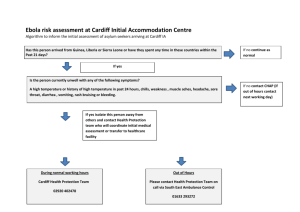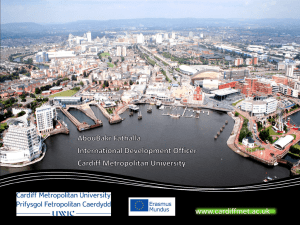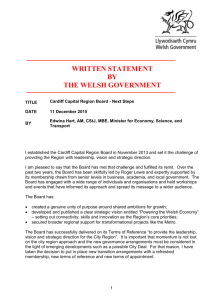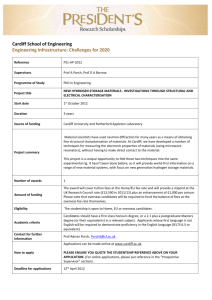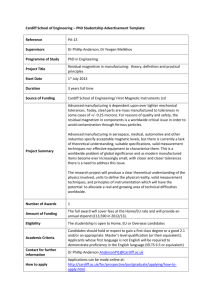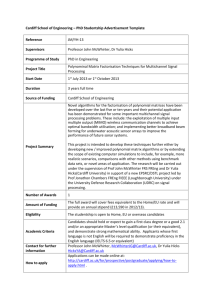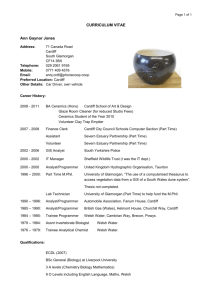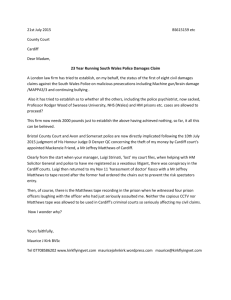Abstracts - British Animal Studies Network
advertisement
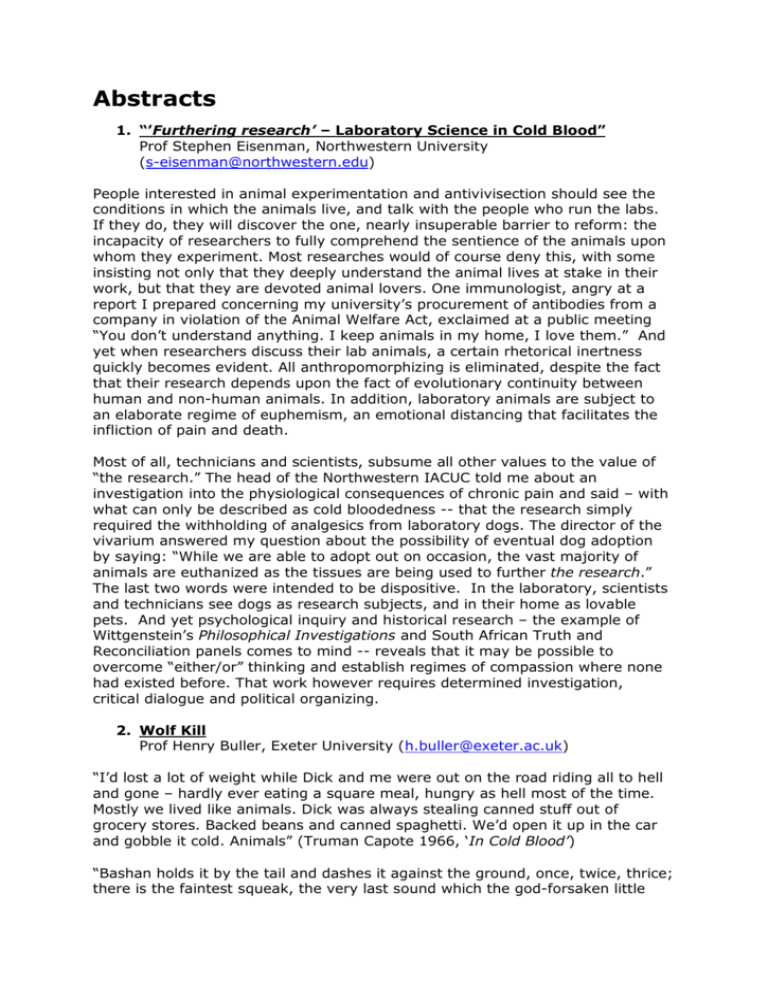
Abstracts 1. “’Furthering research’ – Laboratory Science in Cold Blood” Prof Stephen Eisenman, Northwestern University (s-eisenman@northwestern.edu) People interested in animal experimentation and antivivisection should see the conditions in which the animals live, and talk with the people who run the labs. If they do, they will discover the one, nearly insuperable barrier to reform: the incapacity of researchers to fully comprehend the sentience of the animals upon whom they experiment. Most researches would of course deny this, with some insisting not only that they deeply understand the animal lives at stake in their work, but that they are devoted animal lovers. One immunologist, angry at a report I prepared concerning my university’s procurement of antibodies from a company in violation of the Animal Welfare Act, exclaimed at a public meeting “You don’t understand anything. I keep animals in my home, I love them.” And yet when researchers discuss their lab animals, a certain rhetorical inertness quickly becomes evident. All anthropomorphizing is eliminated, despite the fact that their research depends upon the fact of evolutionary continuity between human and non-human animals. In addition, laboratory animals are subject to an elaborate regime of euphemism, an emotional distancing that facilitates the infliction of pain and death. Most of all, technicians and scientists, subsume all other values to the value of “the research.” The head of the Northwestern IACUC told me about an investigation into the physiological consequences of chronic pain and said – with what can only be described as cold bloodedness -- that the research simply required the withholding of analgesics from laboratory dogs. The director of the vivarium answered my question about the possibility of eventual dog adoption by saying: “While we are able to adopt out on occasion, the vast majority of animals are euthanized as the tissues are being used to further the research.” The last two words were intended to be dispositive. In the laboratory, scientists and technicians see dogs as research subjects, and in their home as lovable pets. And yet psychological inquiry and historical research – the example of Wittgenstein’s Philosophical Investigations and South African Truth and Reconciliation panels comes to mind -- reveals that it may be possible to overcome “either/or” thinking and establish regimes of compassion where none had existed before. That work however requires determined investigation, critical dialogue and political organizing. 2. Wolf Kill Prof Henry Buller, Exeter University (h.buller@exeter.ac.uk) “I’d lost a lot of weight while Dick and me were out on the road riding all to hell and gone – hardly ever eating a square meal, hungry as hell most of the time. Mostly we lived like animals. Dick was always stealing canned stuff out of grocery stores. Backed beans and canned spaghetti. We’d open it up in the car and gobble it cold. Animals” (Truman Capote 1966, ‘In Cold Blood’) “Bashan holds it by the tail and dashes it against the ground, once, twice, thrice; there is the faintest squeak, the very last sound which the god-forsaken little mouse is destined to make on this earth, and now Bashan snaps it up in his jaws, between his strong white teeth. He stands with his forelegs braced apart, his neck bent, and his head stuck out while he chews, shifting the morsel in his mouth and then beginning to munch once more. He crunches the tiny bones, a shred of fur hangs from the corner of his mouth, it disappears and all is over. Bashan begins to execute a dance of joy and triumph round me as I stand leaning on my stick as I have been standing to watch the whole procedure. "You are a fine one!" I say, nodding in grim tribute to his prowess. "You are a murderer, you know, a cannibal!" He only redoubles his activity, he does everything but laugh aloud. So I walk on, feeling rather chilled by what I have seen, yet inwardly amused by the crude humours of life. The event was in the natural order of things, and a mouse lacking in the instinct of self-preservation is on the way to be turned into pulp” (Thomas Mann 1936 A Man and his Dog). The moral parameters for killing animals for food are well, if contentiously, defined. On the whole, we charge ourselves with killing non-humans ‘humanely’ – though of course the reality often falls short. The last 20 or so years has seen the reappearance of wild wolf (canis lupus) populations in parts of South Western France. An estimated 200 or so individuals is now thought to live in the mountainous region of the Alpes and Pre-Alpes. Although their ‘natural’ prey are the wild (and reintroduced) ungulates that live in the region (the chamois, the roe deer, mouflon sheep), the wolves are increasing attacking and killing the domestic sheep flocks that graze on the mountain slopes. Such attacks challenge and upset the order of things. Frequently described as ‘cold blooded’, and rarely involving the subsequent consumption of the sheep as food, they deny the sheep the ‘humane’ (and pre-stunned) death they might come to expect from animal husbandry and re-define their ‘killability’ as belonging to two rather distinct ‘moral’ universes, that of ‘prey’ as well as that of livestock. Farmers might be compensated for the loss of their sheep but the sheep are not compensated for the shift in their moral status and in manner of their dying. How can the wolves be persuaded to respect the sheep and permit them their humane death? 3. ‘In Cold Blood: Deadly Reptiles as Historical Actors’ Dr Krista Maglen, Indiana University (kmaglen@indiana.edu) In 1932 four year old Betty Doherty was taken from the grasp of her older brother by a fourteen foot crocodile in Far North Queensland. Through an examination of historical sources as well as the work of psychologists, cognitive scientists, and zoologists, this paper explores the role ascribed to the crocodile as well as other ‘dangerous’ reptiles that have bitten or consumed settlers across Australia, and asks whether and how they might ‘act’ or be given voices within our reading and understanding of the past. Animal historians have begun to ask questions about historical agency through analyses of domesticated or working animals, and interactions between people and wild mammals. Reptiles, however, remain anonymous and non-specific, disappearing back beneath the surface or into the dark holes from which they emerged, and yet they were often agents of great change in the human lives they encountered. This paper asks whether historical agency and intent can be found in these less sympathetic and less ‘knowable’ cold-blooded creatures, and examines how historians might conceive of watery predators or venomous creatures that disappeared from sight or perhaps were never seen at all. 4. 'Blood Cities: Animal Victims in Maddaddam and Zoo City' Kathryn Halliday, York St John University (kathryn.halliday@yorksj.ac.uk) This paper explores the portrayal of animals as victims in Margaret Atwood’s Maddaddam (2013) and Lauren Beaukes’ Zoo City (2010). In these dystopian narratives, animal/human relations are met with tension and uncertainty, and the boundaries between predator and prey are constantly being redefined. In Maddaddam, it is unclear if the Maddaddamites are the hunters or the hunted, if the Pigoons, the pig-like mammals spliced with human DNA, are the predators or the prey. And in Zoo City, it is difficult to discern if the ‘animalled’ inhabitants of Johannesburg are ‘good’ or ‘bad’, and in turn the extent to which this is imparted to their animal familiars. Both novels depict violence towards animals, including the ritual or ‘muti’ killings of the animals in Zoo City. Drawing on Margaret Atwood’s Survival (1972) and various critical passages on ritual and ‘muti’ killings, I will explore the extent to which Atwood and Beaukes victimise the animals as they appear in both novels. Through my own practice as a writer, I will interrogate ideas on the animal victim, in an attempt to understand the ethics of appropriating violence towards animals in fiction. 5. ‘Caring in cold-blood: Sensing and responding to the needs of aquatic species in the laboratory’ Dr Beth Greenhough, University of Oxford (beth.greenhough@ouce.ox.ac.uk) & Dr Emma Roe, University of Southampton (E.J.Roe@soton.ac.uk) Human capacity to sense and respond to the suffering of non-human animals is key to animal care and welfare. Intuitively these modes of relating seem best suited to interactions between humans and animals who are ‘big-like-us’, warmblooded mammals whose moods and faces humans attempt to read as we would those of another human. Jones (2000) and Driessen (2013) have separately considered the challenges of ethical relatings to cold-blooded aquatic species, while others caution ‘general frameworks for ensuring welfare in other vertebrate animals need to be modified before they can be usefully applied to fish’ (Huntingford, Adams et al. 2006, p333). This paper draws on extracts from interviews with laboratory animal technicians who work with cold-blooded species - describing how they sense and respond to the needs of lobsters, trout, zebrafish and corals - to make three key observations: Firstly, whilst observations of bodies and behaviours predominate in assessments of laboratory mammal welfare, in cold-blooded aquatic species environmental quality serves often as a proxy for species health; secondly regulation for care and use of aquatic and especially invertebrate species is limited; and thirdly, a capacity to learn to be affected, emerging from long periods of co-habitation, seemingly crosses the cold/warm blooded divide (Hayward, 2010; Johnston,2014). 6. “Blood calls blood”: naturist theses on pacifism and vegetarianism Dr Nadia Farage, University of Campinas (nfarage@gmail.com) This paper takes the expression “in cold blood” in its metaphorical sense of cruelty. It will contemplate the reversed meanings the expression acquired in the naturist arguments on pacifism and vegetarianism from the turn of the 19th century on. Naturism – encompassing different groups and ideas – was a minority tendency amidst the anarchist international movement, which flourished between the end of the 19th century until the 1930’s. Broadly, the tendency claimed that human kind, as other species, should live according to nature. The claim that humans were a species among species led naturists to combat animal exploitation, in particular the consumption of their bodies. Departing from Kropotkin, Reclus and Tolstoy, the naturist theory advanced that the consumption of animals affected body and soul, turning one feral and ruthless. On the contrary, human beings who refrained animal blood would be kind tempered, also refusing manslaughter and war. The paper will take the chronicle O Estrela - “Star” (1915) -, by the Brazilian writer Lima Barreto in its connection to the naturist debate, in order to examine the consequences of such theses for the anarchist pacifist and anti-militarist campaigns during World War I. 7. Herpetological Beauty Prof Emily Brady, University of Edinburgh (emily.brady@ed.ac.uk) Snakes occupy an uneasy place in human cultures, sometimes vilified for the fear and revulsion they evoke, and often killed for their skins or as perceived threats. But alongside fear, there is also reverence. In some cultures, snakes symbolize fertility, strength, and other positive qualities and, increasingly, snake fanciers keep them as pets. Aesthetic values and disvalues seem critical to these human-snake interactions, and may both ground destructive relationships to snakes, and relations that benefit snakes, enabling them to flourish. This paper explores a set of aesthetic-ethical issues with respect to these interactions, specifically: negative aesthetics; fascination; beauty; and the apparent absence of anthropomorphic influences in developing human-snake relationships. My principal aim will be to work toward an understanding of how we might overcome aesthetic-based prejudices against snakes – but one that does not reply upon the approach known as ‘positive aesthetics’, which argues that all of ‘wild’ nature is beautiful. 8. Sharks and Humanity at The Oceanographic Museum of Monaco Sarah Wade, University College London (sarah.wade.13@ucl.ac.uk) Between 2013 and 2015, the Oceanographic Museum of Monaco mounted a series of exhibitions and events to raise awareness of the numerous threats faced by sharks, with the aim of changing negative public perceptions of these creatures. Portrayed as ruthless killers in thrillers and making headlines in the wake of attacks, sharks have a fearsome, man-eating reputation, despite the minor threat they pose to humans. Yet in sharp contrast to the view of these creatures as formidable predators is their vulnerability, with more than 100 million sharks meeting their death at the hands of humans each year – caught as by-catch, tangled in fishing nets, or 'finned' in pursuit of controversial, luxury cuisine. By debunking popular myths and revealing their fascinating underwater lives, the Oceanographic Museum of Monaco aimed to promote the protection and conservation of sharks by appealing to the emotions and senses of visitors. This paper considers the strategies used by the museum to this end, exploring how human-shark relations were articulated and activated in the displays and artworks included in this exhibition programme. 9. Knowing fish: ‘Old Warriors’, ‘Wrong ’uns’, and the ballad of ‘Big Vern’ John Clayton, Cardiff University (claytonjl@cardiff.ac.uk) Specimen carp fishing is one of the most popular participation sports in the UK and brings significant revenue to the rural economy every year. The resurgent success of the European Otter has resulted in the predation of specimen fish prized within this angling culture and the resultant conflict provides a window through which some novel more-than-human relationships are revealed. This paper explores the human-carp relation within the contemporary UK setting, performing an exposition of complex assemblages of knowledge, practice and materiality within the milieu of recreational angling. Animal geographers are yet to fully plumb the depths of recreational aquacultures to their full extent. How specimen carp come to be individuated, valued and pursued will be revealed from the perspective of an in progress multi-species ethnography. It will be shown that individual fish acquire ‘history’ through their engagements with anglers and value is codified in their embodied aesthetics, reflecting age, experience and origins. Human practices of movement and selective breeding, both formal and informal, have constructed and reconstructed this species value from food to quarry, in geographically contingent forms. Conflict with resurgent mammalia focuses the differential of values embodied in these intemperate bloods. 10.‘Cold-Blooded Animals in Therapeutic Spaces: Affective Encounters With Unfamiliar Species’ Richard Gorman, Cardiff University (sustainablerich@gmail.com) There are various ways in which non-human life is used within therapeutic practices and spaces - in the UK there are currently around 4,500 active ‘Pets as Therapy’ dogs, visiting over 130,000 people per week (Pets As Therapy, 2015), whilst more than 180 UK farms function as ‘Care Farms’ (Bragg, 2013), combining agricultural production with health, social, and educational services. However, these programmes exclusively work with mammalian (and occasionally, avian) species; cold-blooded creatures have been marginalised within therapeutic spaces. This paper will therefore explore the use of reptiles and amphibians in forms of therapeutic process, and the roles of these more ‘unfamiliar’ species in contributing to experiences of health and space. Through discussing the challenges and opportunities of using more ‘exotic’ species, we must recognise the potential for the simultaneous creation of “restorative places and scary spaces” (Milligan & Bingley, 2007). Drawing on interview data with organisations and practitioners utilizing coldblooded species of animals for structured therapeutic engagements, this paper highlights how non-mammalian lifeforms can create and facilitate therapeutic engagements with place and practice. Further, the paper will demonstrate how cold-blooded species can create very different affective encounters within interspecies therapeutic practice, compared to conventional mammalian based animal assisted therapies and interventions. 11.Heidegger’s Lizard, or the As-Such of the Sun Rodolfo Piskorski da Silva, Cardiff University (PiskorskiR@cardiff.ac.uk) In The Fundamental Concepts of Metaphysic, Heidegger expounds on his now famous division of beings with respect to “world”: stones are world-less, animals are poor in world, and human beings (Dasein) are world-forming. This hypothesis is then analysed “from the middle” – beginning with the animal’s “poorness” in world – so that Heidegger can reach his conclusions about “the world” itself. Heidegger’s example of animal life is a lizard, basking in the sun on a rock as they are wont to do. The rock in this scenario offers him the possibility of comparing animal and stone being, whereas the sun that warms the lizard’s (cold) blood will furnish the means of comparison between human and animal. The lizard has a special and meaningful relationship to the sun, Heidegger concedes, in that it depends on the star for its bodily warmth. The lizard cannot, however, perceive the sun as such, that is as the sun. The same is true about the rock, but the as-such of the sun seems to hold much more persuasive power for Heidegger. I shall discuss this (famous) Heideggerian example of animal life insofar as it necessarily depends on the cold-bloodedness of the lizard, as well as in relation to Derrida’s contention that there can be no “as such” of the sun. 12.(Re)inscribing animality in cultural others Colin Salter, University of Wollongong (csalter@uow.edu.au) Somewhat routinely, those who commit violent crimes, including harming Other animals, are described using terms including ‘cold blooded’. Such descriptions emanate from politicians, law enforcement, and mainstream and progressive media. As a metaphor, the implication is that such individuals imbue an absence of humanity and human emotion. They are cold. They are animal-like. In his paper, I will draw from the dispute over whaling in the Southern Ocean to illustrate similar phenomena in the actions of those opposed to the killing of whales. In particular, how Japanese whalers are identified as cold. The aim is to illustrate that, alongside already problematic exceptionalist underpinnings, the relational construction of the cultural Other includes a (unintentional) reinscription of species hierarchy. In short, in seeking to challenge actions that harm whales, those doing the harm are effectively rendered as animal-like (in a derogatory sense) and less than human. 13. Ant-ic Actions – an experiential exploration of the ethics of co-production Fiona MacDonald, Visual Artist (fiona1macdonald@gmail.com) The paper will detail the intertwined agential and ethical questions raised by my creative interactions in two Kent forests, in 2014 and 2015, with wood ants (Formica rufa). My practice aims to be sensitive to the places, species and ecologies with which I work, but not to leave - either me or them - as I found them. I am ‘interfering’ with the natural processes and activities of my subjects, but as an artist intraand interacting with, rather than a scientist studying the natural world, this is intentional, indeed pivotal. During Ant-ic Actions, however, I directly, though inadvertently, caused the death of some of my ‘co-workers’. My paper will draw on Donna Haraway, Steve Baker, Paul Cloke & Owain Jones, and Brian Massumi to interrogate my own assumptions around coldbloodedness, size and numerosity in the making of, and the implications of, these artworks. I will question whether one’s level of moral responsibility increases when making art (as opposed to, say, making dinner). My paper offers no clear moral boundaries, but aims to ‘take responsibility’ as artist Mark Dion’s manifesto put it. 14. Psychopathy aside, perhaps cold-bloodedness is a condition we enter into out of need Bonita, Alice, visual artist (bonitaalice@gmail.com) My paper incorporates fragments of a 3-way multidisciplinary discussion held earlier this year in Johannesburg, South Africa to accompany an exhibition of my paintings and drawings. Within our respective practices, my 2 colleagues and I have attempted to understand the emotional dynamic in play, in particular, the emotional distancing that occurs, during the routine subjugation of the rights of non-human beings. I describe how we’ve all 3 considered concepts at the core of psychoanalytic thinking, primarily, Repression, the term within Psychoanalysis for the defense against unacceptable impulses or ideas, the mechanism by which certain ideas or feelings are rendered unconscious. In my (Visual Art) practice I attempt to evoke in images the anxiety (I believe comes from both sides) in the space between ourselves and non-human animals. Psychologists make a link between anxiety and Repression. In this context I imagine this anxiety to be associated with trauma following what is essentially our betrayal of a past relationship with other animals in which we held them in much higher regard. I discuss a few of my images (and strategies) and introduce aspects of the discussion that grew around them. For instance, the title of the work, Strangers of Commanding Aspect (in which a non-human subject is called ‘stranger’), introduces the idea that, paradoxically perhaps, we only use the word “stranger” for someone we consider sufficiently like ourselves. I introduce (artist and academic) Anne-Marie Tully’s comments, in response to this work, regarding the representation of non-human subjects and the possible ways in which artists might avoid the animal subject becoming simply a vessel for our projections. Although an artist must communicate on a different frequency than an activist, there are similarities in the strategies available to both, as both essentially are trying to influence the way people think and bring them out of a torpor of not feeling. As well as attempting to understand these dynamics (Lecturer in Jurisprudence) Sarah-Rutherford Smith has observed the limitations of the Law where environmental and animal rights activism is concerned and suggests that a fundamental shift in thinking is the route to finding alternative strategies to protect animal rights. I briefly discuss her paper about the Kassandra Dilemma, and some of her thoughts on what I’ve described above; her suggestion, for instance that answers might be found within the strategies employed historically by activists – the Suffragette Movement for example - whose successes are now considered cornerstones of a progressive and just contemporary society. 15.Writing in Cold Blood: Thirty Ways of Looking at the Sea Susan Richardson, Marine Conservation Society (susan@susanrichardsonwriter.co.uk) This presentation will draw on my current role as poet-in-residence with the Marine Conservation Society, and my experience of writing poems, and devising/facilitating poetry workshops, for their Thirty Threatened Species Appeal. The aim of the residency, and of my wider practice as an ecopoet, is to encourage those who engage with such themes as biodiversity loss and specieslevel extinction through the medium of poetry to develop a more enduring connection with wildlife conservation issues, which can potentially lead to behaviour change. Of the thirty vulnerable, endangered and critically endangered species on which I am concentrating in the course of my residency, two-thirds are fish and reptiles, and my presentation will examine the particular challenges that have arisen in the process of writing about, and inspiring others to write about, cold-blooded animals. I will also make reference to the poetry workshops I have previously devised for WWF, as well as my 2013 residency with Friends of the Earth's Bee Cause, to explore how, and to what extent, writing about mammals and social insects differed from my current fish-andreptile focus. My analysis will be illustrated by performances of several of my commissioned Thirty Threatened Species poems (due to be published as a collection by Cinnamon Press in 2017). Biographies of Speakers Bonita Alice (bonitaalice@gmail.com) I’m a London-based visual artist. Born South Africa, 1962. BAFA University of the Witwatersrand, 1984. MFA Michaelis School of Arts, University of Cape Town, 1990. My solo exhibitions include: 2015 - Strangers of Commanding Aspect - Gallery AOP, Johannesburg 2012 - Beast in a Dangerous Landscape - Gallery AOP, Johannesburg 2010 - Beast at Home - Gallery AOP, Johannesburg 2007 - Anticipated Memory - Gallery AOP, Johannesburg 2005 - Promised Land - The Premises Gallery, Johannesburg Prior to my move to the UK in 2007, I lectured in various Fine Art Departments in South Africa. I left my last academic post (1999 – 2003), Lecturer in Sculpture, Department Fine Art, Technikon Witwatersrand, now, University Of Johannesburg, to make art full-time. www.bonitaalice.blogspot.com Emily Brady (emily.brady@ed.ac.uk) Emily Brady is Professor of Environment and Philosophy in the Institute of Geography and an Academic Associate in Philosophy at the University of Edinburgh. Her research interests span aesthetics, environmental ethics, Kant, and eighteenth-century philosophy. Within animal studies, she is interested in issues such as autonomy, respect, sentimentality, and difference in our aesthetic engagement with animals. She has written articles on the place of animals in ecological art, and the role of expressive qualities in aesthetic engagement with wild animals. She has published several books in aesthetics and environmental philosophy, as author: The Sublime in Modern Philosophy: Aesthetics, Ethics, and Nature and Aesthetics of the Natural Environment; and as co-editor: Aesthetic Concepts: Essays After Sibley; Humans in the Land: The Ethics and Aesthetics of the Cultural Landscape; and Human-Environment Relations: Transformative Values in Theory and Practice. Henry Buller (h.buller@exeter.ac.uk) Henry Buller is Professor of Geography at the University of Exeter. He has a longstanding interest in animal geographies with a particular focus on farm animals (including farmed fish) and farm animal welfare. Author of three Progress Reports on Animal Geography in the journal Progress in Human Geography, in addition to a number of articles and chapters on human/animal relations, he is a member of the Farm Animal Welfare Committee and Chair of the FAWC/Defra Welfare at Killing Committee. John Clayton (claytonjl@cardiff.ac.uk) John’s research adopts a more-than-human paradigm to explore the interactions of anglers’, carp and otters, within specific recreational fisheries which have a history of predation. Within these sites he is exploring how conditions of conflict between humans and non-humans are expressed within their respective relations. At present he is working on innovative methodological practices that seek to evidence the material and affective connections that exist between humans and animals. At RGS-IBG 2014 he presented a paper in the ‘Historical Animal Geographies’ session, concerning the individuation of a fish named ‘Clarissa’, caught in 1952, and how this became the foundational story of a specialist practice. More broadly he is seeking to root research within a Deleuzian tradition whilst exploring Von Uexkull’s notion of the umwelt as an explicitly spatial framework through which to diagram relationality between humans, animals and their environments. Forthcoming, 2016: Encyclopaedia of Human-Animal Co-existence; ‘Fishing’. Stephen Eisenman (s-eisenman@northwestern.edu) Stephen F. Eisenman is Professor of Art History and the author of seven books including Gauguin's Skirt (1997), The Abu Ghraib Effect (2007), and The Cry of Nature -- Art and the Making of Animal Rights (2013). He has curated major exhibitions in the United States and Europe, including Design in the Age of Darwin (2007), Paul Gauguin -- Artist of Myth and Dream (2008), The Ecology of Impressionism (2010) and William Blake in the Age of Aquarius (forthcoming, 2016). He is also the principle author and editor of the textbook Nineteenth Century Art: A Critical Edition (fourth edition 2010). Apart from his art history and animal studies scholarship, Eisenman is an activist: From 2008 to 2013, he was spokesman for the successful prison reform organization, Tamms Year Ten. His op-eds, articles and letters on prison issues and animal rights have appeared in the Chicago Sun-Times, Monthly Review and the New York Times. He is currently President of the Northwestern University Faculty Senate Nadia Farage (nfarage@gmail.com) Nádia Farage is Associate Senior Lecturer II at the Department of History and the Centre for the Social History of Culture (CECULT) at the Institute of Philosophy and Human Sciences, University of Campinas, Brazil. An ethnohistorian, she is the author of several publications on Northern Amazonian history and literature. In recent years, she has been working on libertarian and naturist struggles for animals in modern Brazil. She is currently responsible for animal studies at the Post-Graduate Programme in Social Anthropology at her university. Rich Gorman (sustainablerich@gmail.com) Rich Gorman is a PhD student in Cardiff’s School of Planning and Geography, funded by the Economic and Social Research Council and Cardiff University’s President’s Scholarship. Rich is interested in the uses of animals within structured care farming practices, and how animal life can help create a space of positive health and wellbeing for vulnerable people. Rich’s research seeks to develop a critical understanding of the role of non-humans within geographies of therapeutic spaces; exploring how animals’ positioning within these landscapes can be ambiguous and unstable. Rich’s research also cross-cuts into exploring local and alternative food networks, particularly Community Supported Agriculture (CSA) farms and projects, and critically examining the contested roles of the animals on these farms, aiming to contribute to contemporary understandings of human-animal relationships. Beth Greenhough(beth.greenhough@ouce.ox.ac.uk) Associate Professor of Human Geography and Fellow of Keble College, University of Oxford. Her work explores how humans and animals become resources for biomedical research, including issues such as the ways in which people are recruited as biobank donors or clinical trial subjects and the laboratory animal welfare. Kathryn Halliday (kathryn.halliday@yorksj.ac.uk) Kathy Halliday is a writer and practice-led PhD candidate at York St John University. She is also a (post)graduate of the University’s Creative Writing and English Literature BA (Hons) and Creative Writing MA programmes, respectively. Her creative works have appeared, both online and in print, at Ink, Sweat & Tears, The Cadaverine, Little Fiction and Turbulence Poetry. Her work is primarily concerned with interrogating the appropriation of non-human animal bodies for creativity. Her current research interests include, but are not limited to, evolution, animal/human transformation, anthropomorphism, transgenic animal bodies and posthumanism. She blogs at feathersintherain.wordpress.com. Fiona MacDonald (fiona1macdonald@gmail.com) Fiona MacDonald lives and works in Kent. She is a visual artist working primarily in response to place and to interaction with the nonhuman. MacDonald pursues an exploratory, ludic and intimate connectivity with nonhuman life, which does not set species boundaries or nature/culture divides too firmly. Her ethical framework draws on Jane Bennett’s ‘vital materialism’ which describes increased sensitivity to the nonhuman through a reappraisal of the vitality of nonhuman actants; and Timothy Morton’s ‘interdependence theorem’, which posits a radical decentring of the human, foregrounding our ‘unbearable intimacy’ with other life. MacDonald’s current activities include Woodland Portrait Project: a persistent artistic engagement with one “smallish, ordinary-extraordinary wood near the M25 in Kent”. Work from WPP forms solo exhibitions at Peacock Visual Arts, Aberdeen and Kaleidoscope, Sevenoaks this year. There is also a significant display of her work in Thirteen Blackbirds Look at a Man, Chapter, Cardiff, JulySep 2015. Previous solo exhibitions include Morphology, Maddox Arts, London 2009; Anthropoflora, Long and Ryle, London 2007 and Habitat, Phoenix, Brighton 2006. Residencies include Stour Valley Arts’ Forest Studio in 2014 and the Abbey Fellowship in Painting at the British School at Rome in 2011. www.fiona1macdonald.wordpress.com www.feralpainting.wordpress.com Krista Maglen (kmaglen@indiana.edu) Krista Maglen is an assistant professor in the history department at Indiana University, Bloomington. Her first book explores the defining of risk and demarcation of space through practices and policies of disease control in nineteenth century Britain. Her new work examines similar themes in relation to dangerous native animals in Australia. Rodolfo Piskorski da Silva (PiskorskiR@cardiff.ac.uk) Rodolfo Piskorski is a PhD student in the Centre for Critical and Cultural Theory at Cardiff University. His research explores the inter-connectedness of animality and textuality. He has presented in various Animal Studies conferences, such as Minding Animals, Reading Animals,Human-Animal Studies Conference, and Humanity and Animality in the 20th and 21st Centuries, and has published in Humanimalia, and The Journal of Critical Animal Studies. Susan Richardson (susan@susanrichardsonwriter.co.uk) A poet, performer and educator specialising in wildlife conservation and other environmental concerns. Her third collection of poetry, skindancing, themed around human-animal/non-human animal metamorphosis and our dys/functional relationship with the wild, has just been published by Cinnamon Press. Susan has performed her work nationally and internationally and been resident poet on BBC Radio 4’s Saturday Live. She has more than sixteen years’ experience of coaxing people of all ages and backgrounds to engage with environmental themes through poetry in an imaginative, dynamic way. She has been visiting academic at Flinders University in Australia, and has facilitated workshops for a wide range of organisations including WWF, Friends of the Earth, the Dark Mountain Project, the Fort William Mountain Festival, the Green Party, and numerous schools and Universities throughout the UK. She is currently poet-in-residence with both the Marine Conservation Society and the global animal welfare initiative, World Animal Day, and is a fellow of the International League of Conservation Writers. For further information, please visit www.susanrichardsonwriter.co.uk Emma Roe (E.J.Roe@soton.ac.uk) Lecturer in Human Geography at the University of Southampton and specializes in the social scientific study of farm animal welfare, questions of how ethics are carried out in practice and ecological citizenship. Colin Salter (csalter@uow.edu.au) Colin Salter is an Honorary Fellow in the School of Humanities and Social Inquiry at the University of Wollongong. His research interests include microsociology (activism as subcultural practice), critical animal studies, postcolonial studies and the criminalisation of dissent. He focusses primarily on the intersections and social constructions of race, species, gender and class — in particular how these shape and co-constitute identity across activist struggles. His publications include the books Animals and War, 2014 (co-editor)—winner of the Central New York Peace Studies Consortium Peace Studies Book of the Year Award; Whiteness and Social Change, 2013; and papers Animals and War: Anthropocentrism and Technoscience, 2015; Intersections of the colonial and postcolonial: pragmatism, praxis and transformative grassroots activism at Sandon Point, 2014; and Activism as Terrorism: The Green Scare, Radical Environmentalism and Governmentality,2011. He recently guest edited a special issue of Animal Studies Journal (2015) Sarah Wade (sarah.wade.13@ucl.ac.uk) Sarah Wade is completing her PhD Reintroducing Wonder: Contemporary Artistic and Curatorial Engagements with Wildlife in the department of History of Art at University College London. Her research interrogates human-animal relations and representations of animals in contemporary art and museum display, exploring how these practices might evoke a sense of wonder reminiscent of responses to the early modern wunderkammer. She is interested in hunting trophies, conservation, anthropomorphism and ideas of 'becoming animal' in contemporary art. She was recently a co-curator of the exhibition Strange Creatures: The Art of Unknown Animals (2015) at The Grant Museum of Zoology London and organised the conference Collecting the Sea: 1500-2015.
